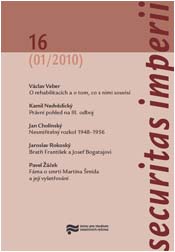Fáma o smrti Martina Šmída a její vyšetřování Rekonstrukce vyšetřovacího spisu Státní bezpečnosti
The last reorganisation of the intelligence service Staff reductions at the Central Intelligence Directorate of the National Security Corps in the years 1988–1990
Author(s): Pavel ŽáčekSubject(s): Security and defense, Management and complex organizations, Post-War period (1950 - 1989), Transformation Period (1990 - 2010)
Published by: Ústav pro studium totalitních režimů
Keywords: Martin Šmíd; November 1989; Velvet revolution; Czechoslovakia
Summary/Abstract: In April and May 1988, the leadership of the Federal Ministry of the Interior began an extensive reduction of the security apparatus. For example, the Chief of Staff of the National Security Corps’ Central Intelligence Directorate, Brigadier Karel Sochor, informed the Minister of the Interior of the Czechoslovak Socialist Republic, Vratislav Vajnar, of the need to reduce the number of officers in the First Directorate of the National Security Corps by 30%. According to the stipulated numbers, the headquarters of communist intelligence were meant to comprise 1030 planned job positions, but in reality there were 905 staff officers and 69 civilian workers. 588 people worked as operatives at home and abroad (the plan anticipated 63 more). Among other things, in the months that followed and in connection with the reorganisation of the intelligence service, management at the National Security Corps’ First Directorate also conducted a number of analyses of the personnel structure of headquarters’ operational departments, “legalised“ officers in the so-called First Reserve (operating under the cover of various departments and organisations in the Czechoslovak Socialist Republic) and the Second Reserve, which primarily performed its tasks abroad in “rezidenturas” (a rezidentura was roughly equivalent to a CIA station). Using various calculations, they attempted to defend themselves against overt political pressure to reduce their apparatus whose privileged position was based on National Defence Council Resolution 33, dated 9 December 1982. During the last years of its existence, the National Security Corps’ Central Intelligence Directorate was forced to repeatedly defend its activity and to inform a number of unauthorised officials from the state and Party apparatus of confidential facts concerning its work, including cooperation with its partners (who included the USSR). It was only under the new political conditions which prevailed at the beginning of 1990 that management at the First Directorate of the National Security Corps accepted a 30% reduction in its staffing levels and the streamlining of its organisational structure. The study is supplemented with documents concerning an overview of the “legalised” posts of the First and Second Reserves – which operatives used as cover for their real work and which were assigned to the intelligence service for operational use in the Czechoslovak Socialist Republic and abroad according to individual departments (October 1982), the focus and most important tasks of foreign rezidenturas in the final period (March 1989), and a list of intelligence officers in the diplomatic corps (March 1989).
Journal: Securitas imperii
- Issue Year: 2010
- Issue No: 16
- Page Range: 136-192
- Page Count: 57
- Language: Czech

